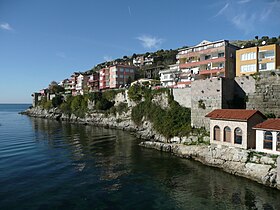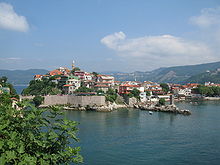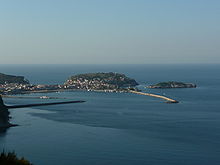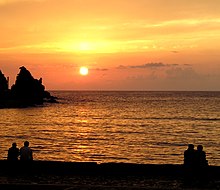Amasra
| Amasra | ||||
|
||||
 View of Amasra from the bridge |
||||
| Basic data | ||||
|---|---|---|---|---|
| Province (il) : | Bartın | |||
| Coordinates : | 41 ° 45 ' N , 32 ° 23' E | |||
| Residents : | 6,085 (2018) | |||
| Telephone code : | (+90) 378 | |||
| Postal code : | 74 300 | |||
| License plate : | 74 | |||
| Structure and administration (as of 2019) | ||||
| Structure : | 5 malls | |||
| Mayor : | Timur Recai Çakır ( CHP ) | |||
| Website: | ||||
| Amasra County | ||||
| Residents : | 14,776 (2018) | |||
| Surface: | 178 km² | |||
| Population density : | 83 inhabitants per km² | |||
| Kaymakam : | Mehmet Yıldız | |||
| Website (Kaymakam): | ||||
Amasra (also Sesamos , Greek Ἄμαστρις Amastris ) is a Turkish port city on the coast of the Black Sea in the ancient landscape of Paphlagonia in today 's Bartın province . Amasra is also the capital of the district of the same name in the north-west of the province. Tourism is the main source of income for the residents.
The district was founded in 1987 in the province of Zonguldak and in 1991 moved with three other districts from there to the newly founded province of Bartın . The only municipality is the district town (Merkez), there are also 30 villages, none of which have more than 600 inhabitants. Almost half of the district's population (41.2%) lives in the district town.
geography
Amasra is located on a peninsula and on the island of Büyük Ada (Eng. Big Island ), which is connected to the peninsula by a sizable single-arch bridge built during the Eastern Roman era in the 9th century. In front of the place is another uninhabited island, the "Rabbit Island" (Tavşan adası) . On the peninsula there is the destroyed Eastern Roman citadel and the city wall, which stretches along the two inhabited districts with a double gate in front of the bridge and an impressive course, with square towers attached to the outside and partly with internal supporting pillars; some ancient small monuments are built into the wall.
history
The name Amasra comes from the Persian noblewoman Amastris († 284 BC), a daughter of Oxyathres , the brother of Dareios III. Through a union of the four places Sesamos (at the place of today's Amasra), Kytoros, Kromna and Tios ( Synoikismos ) the Persian princess founded 300 BC. The city of Amastris named after her on the coast of Paphlagonia . There she minted coins with the inscription Queen Amastris . When the sons of the Amastris were old enough, they took over the government under their mother's suzerainty, but disagreements soon broke out between them. Allegedly, Amastris was born in 284 BC. Drowned at the instigation of her sons.
According to a local myth, the city of Amasra was submerged in the sea and in the middle of the 11th century. resurfaced AD . In 1261 the Genoese took control of the Black Sea trade after the Nymphaion Agreement . The Genoese rule over the city ended in 1460 when the Ottoman Empire under the leadership of Sultan Mehmed II conquered the city and the entire Anatolian shore of the Black Sea, after which Amasra became wealthy again. Today the small town belongs to the Bartın province on the Black Sea coast.
economy
| 40% | Agriculture |
| 40% | Mining |
| 15% | fishing |
| 5% | Public administration |
climate
Climate table (2007) The city has a mild, humid maritime climate. The average annual temperature is 19 ° C. The warmest month is July with an average of 34 ° C, the coldest is January with an average of 6 ° C. Winter is determined by changeable weather: there are spring-like sunny days, frequent rain and cold snaps, and often snowfalls. The annual rainfall is 425 mm.
| month | Maximum temperature | Lowest temperature | Rainydays | Hours of sunshine |
|---|---|---|---|---|
| January | 9 | 3 | 17th | 3.6 |
| February | 9 | 0 | 14th | 4.2 |
| March | 12 | 3 | 13 | 4.5 |
| April | 16 | 9 | 9 | 6.6 |
| May | 23 | 14th | 5 | 8.9 |
| June | 32 | 22nd | 3 | 11.8 |
| July | 39 | 24 | 2 | 12.1 |
| August | 32 | 20th | 3 | 11.3 |
| September | 25th | 15th | 6th | 9.2 |
| October | 21st | 12 | 10 | 7.6 |
| November | 15th | 9 | 13 | 5.8 |
| December | 11 | 5 | 17th | 3.3 |
Culture and sights
The Fatih Mosque by the citadel was formerly a Christian church and has been modernly restored. Sights are also the hammam , the theater and the Hellenistic city wall. The numerous finds from the Hellenistic, Roman, Byzantine and Ottoman times are exhibited in the Archaeological Museum.
Located between mountains and bays that extend to the sea, the sandy beaches in the east of the city are particularly suitable for swimming. There are the Çakraz , Bozköy and Akkonak beaches. There are numerous fish restaurants on the coast.
museum
In 1955 the first museum was opened, which consisted of a small hall in the parish building. On January 30, 1982, this building was reopened as a larger museum for visitors. It comprises one floor with four exhibition rooms. Most of the objects come from Amasra and the surrounding area and belong to the Hellenistic, Roman, Eastern Roman, Genoese and Ottoman periods.
- 1. Archaeological Hall: Here you will find clay and glass vessels, tear bottles, handicrafts made of gold and bronze and amphorae recovered from the sea . There are also bronze statues, crosses, weapons, and gold, silver and bronze coins on display.
- 2. Archaeological Hall: This is dedicated to marble works from the Hellenistic, Roman and Eastern Roman periods. Statues, busts, grave and other architectural parts can be viewed here.
- 1. Ethnographic room: This room contains small exhibits from the late Ottoman period. These include bronze kitchen vessels, weapons, writing implements, candle holders, stamps, ceramics and rings, as well as wooden vessels, which are evidence of Amasra's traditional art of carving.
- 2. Ethnographic hall: Here you will find items of clothing and handicrafts made of silver, as well as bed and upholstery throws, Koran manuscripts, carpets, bags and wall clocks. In the corridor of the museum hangs a map of the Mediterranean from 1852, which was produced in the printing works of the Sultan's Serail in Constantinople. There are small stone monuments in the museum garden.
Personalities
- Barış Akarsu , musician and actor
media
Film productions made in Amasra:
- Gönderilmemiş Mektuplar - The love letters
- Gülbeyaz ( White Rose )
- Fikrimin ince gülü ( The delicate rose of my idea )
- Homicide Squad Istanbul . Episode A Village Under Suspicion (ARD, broadcast date January 12, 2017)
Town twinning
-
 Fontaniva in the province of Padua (since 2005)
Fontaniva in the province of Padua (since 2005)
literature
- Eyice, Semavi: Deux anciennes églises byzantines de la citadelle d'Amasra (Paphlagonie) , in: Cahiers Archéologiques 7, 1954, pp. 97-105
- Ders .: Küçük Amasra tarihi ve eski eserleri kılavuzu. Türk Tarih Kurumu Basımevi, Ankara 1965.
- Gustav Hirschfeld : Amastris 1) . In: Paulys Realencyclopadie der classischen Antiquity Science (RE). Volume I, 2, Stuttgart 1894, Col. 1749.
- Crow, James - Hill, Stephen: Amasra, a Byzantine and Genoese Fortress on the Black See , in: Fortress 5, 1990, pp. 3-13
- Diess .: The Byzantine Fortifications of Amasra in Paphlagonia , in: Anatolian Studies 45, 1995, pp. 251-265
- Marek, Christian : Catalog of the inscriptions in the Museum of Amasra , with an appendix The inscriptions of Amastris and the alleged Pompeian era of the city , in: Epigraphica Anatolica 6, 1985, 133–156
- Ders .: Amastris 2. In: Der Neue Pauly (DNP). Volume 1, Metzler, Stuttgart 1996, ISBN 3-476-01471-1 , Sp. 574.
Individual evidence
- ↑ a b Nufusune.com , accessed on April 15, 2019





